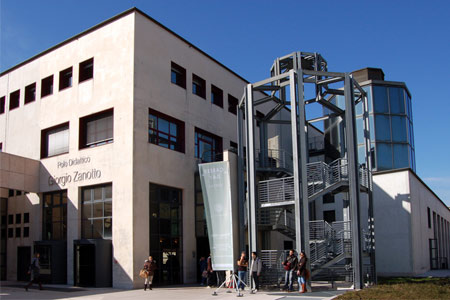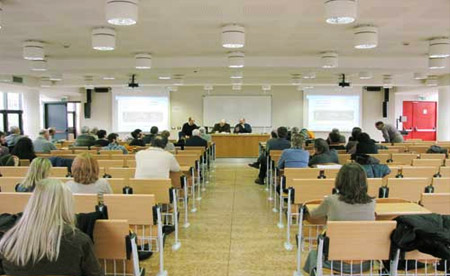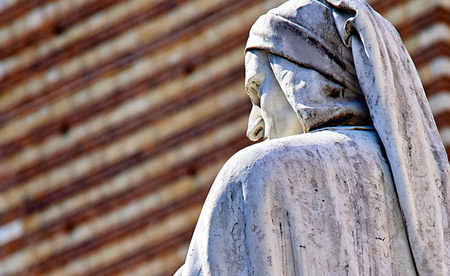Women artists, women patrons, spaces and works for women. Some exemplary cases between the 12th and the 15th century.
The course will deal with the role of women in the art production and patronage through some exemplary cases focused on the religious and profane context. The analysis will extend to the European situation; however, a constant reference to the Veneto region will be also made, with specific attention to Verona and Padua.
Although there are several evidences of female patronage between the 12th and the 15th century, little is known on women artists. Nevertheless, the course will focus on documentary witnesses and works that can be attributed to female artists. In particular, the surviving evidences concern the art of embroidery, the art of weaving, and the production of books, with documented interventions in copying texts as well as in illuminating them. In addition, the analysis will regard some cases in which women were involved in the more complex role of authors and co-ordinators for the execution of the whole work. Besides, special attention will be given to the spaces of the female devotion, namely the cloistered convents and the works bound to the needs of the religious community.
The definitive program:
SAGGI A CARATTERE GENERALE
(*) P.C. CLAUSSEN, Artista, in Enciclopedia dell’arte medievale, Roma 1991.
(*) B. BREANK, Committenza, in Enciclopedia dell’arte medievale, Roma 1994, pp. 203-218
(*) X. BARRAL I ALTET, Donne committenti e donne artiste nel romanico europeo: una questione aperta dell’arte medievale, in Matilde di Canossa e il suo tempo, atti del convegno (San Benedetto PO, Revere, Mantova 2015), II, Spoleto 2016, pp. 729-746.
A. ROBERTS, Before the Council of Trent (1545-1563), in Dictionary of Women Artists, I, ed. By D. Gaze, London – Chicago 1997, pp. 21-23.
G. VALENZANO, Donne negate: le artiste nel Medioevo, in Le plaisir de l’art du Moyen Âge. Commande, production et réception de l’œuvre d’art. Mélanges en hommage à Barral i Altet, Paris 2012, pp. 252-57
A. WEYL CARR, Women as Artists in the Middle Ages. “The Dark is Light Enough”, in Dictionary of Women Artists, I, ed. By D. Gaze, London – Chicago 1997, pp. 3-21
ARTE DEL RICAMO E DELLA TESSITURA
S. GREENNUP, Mabel: l’arte del ricamo in Inghilterra, in Artifex bonus. Il mondo dell’artista medievale, a cura di E. Castelnuovo, Bari 2004, pp. 128-137
HORTUS DELICIARUM
C. POGGI, M. SANTINI, La Bibbia nell’Hortus deliciarum, in Donne e Bibbia nel Medioevo (secoli XII-XV) tra ricezione e interpretazione, a cura di K. E. Børresen e A. Valerio, Trapani 2011, pp. 331-347
(*) P. VITOLO, L’Hortus Deliciarum di Herrada di Hohenburg. 1. Immagine della donna e strategie narrative nell’Hortus deliciarum, in Donne e Bibbia nel Medioevo (secoli XII-XV) tra ricezione e interpretazione, a cura di K. E. Børresen e A. Valerio, Trapani 2011, pp. 319-330
Joyner 2016
CLARISSE
(*) C. A. BRUZELIUS, Nuns in Space: Strict Enclosure and the Architecture of the Clarisses in the Thirteenth Century, in Clare of Assisi: A Medieval and Modem Woman, St Bonaventure, N.Y. 1996 (Clare Centennary Studies, vol. 8), pp. 53-74
E. ZAPPASODI, Sorores reclusae. Spazi di clausura e immagini dipinte in Umbria fra XIII e XIV secolo, Firenze 2018, pp. 9-26, 79-104
(*) F. CODEN, Architettura Religiosa Campo Marzio a Verona, in Santa Marta. Dalla Provianda al Campus universitario, a cura di V. Terraroli, Sommacampagna 2015, pp. 25-41
(*) T. FRANCO, Fuori dal mondo: le clarisse di Santa Maria delle Vergini in Campo Marzio (XIII-XIV secolo), in Santa Marta. Dalla Provianda al Campus universitario, a cura di V. Terraroli, Sommacampagna 2015, pp. 15-24
PADOVA : ANNA E FINA BUZZACARINI
A.M. SPIAZZI, Giusto a Padova. La decorazione del Battistero, in Giusto de’ Menabuoi nel Battistero di Padova, a cura di A.M. Spiazzi, Trieste 1989, pp. 83-127
B.G. KOHL, Fina da Carrara, née Buzzacarini: Consort, Mother and Patron of Art in Trecento Padua, in Beyond Isabella: Secular Women Patrons of Art in Renaissance Italy, Kirksville 2001, pp. 19-35
G. CARRARO, D. GALLO, Premessa, in L’elogio di Anna Buzzacarini, badessa di S. Benedetto Vecchio di Padova in un codice di età carrarese, Padova 2018, pp. 15-56
(*) G. VALENZANO, Z., MURAT, Donne dimenticate. Esempi di committenza femminile nel Veneto medievale, in Medioevo. I committenti, atti del convegno a cura di A. C. Quintavalle, Milano 2011, pp. 187-200.
CHRISTINE DE PIZAN
M. MEISS, The Limbourg and their Contemporaries, New York 1974, pp. 7-41, 283-296
M.G. MUZZARELLI, Un’italiana alla corte di Francia. Christine de Pizan, intellettuale e donna, Bologna 2017, pp. 55-83 (capitoli Lady in blue, Nello specchio delle miniature, Con la zappa e la cazzuola), 127-135 (capitolo Committenti, destinatari, lettori, lettrici)
P. CARAFFI, Introduzione, in Christine de Pizan, La città delle dame, ed. di E. J. Richards, Roma 2017, pp. 9-30







